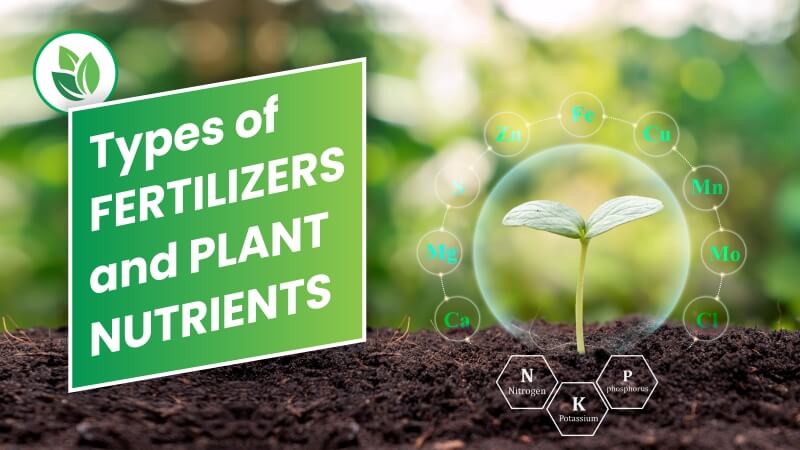What are Fertilizers?
The addition of fertilizer to the soil helps plants grow and produce more. Fertilizer technology advanced greatly when ancient farmers learned about the chemical requirements of growing plants. With the addition of other nutrients, modern chemical fertilizers are primarily made of compounds of nitrogen, phosphorous, and potassium. Despite environmentalists’ concerns about their long-term usage, chemical fertilizers have considerably enhanced the quality and amount of food available today.
Plants are made up of cells, much like all other living things. Numerous metabolic chemical processes that are necessary for development and reproduction take place within these cells. Plants rely on nutrients in the soil to supply the essential chemicals for these metabolic events because they do not consume food as animals do. However, because there is a finite amount of these substances in soil, as plants are harvested, their availability decreases, which lowers plant quality and production.
Chemical elements that developing plants remove from the soil and replace with fertilizers. However, they are also intended to increase the soil’s capacity for growth, and fertilizers can produce a more favorable growing environment than organic soil. Additionally, they can be modified to fit the crop being cultivated. Fertilizers are often made of substances containing nitrogen, phosphorus, and potassium. They also include trace elements that help plants develop more effectively.
Types of Plant Nutrients:
The three most important nutrients for plants are carbon, oxygen, and hydrogen, which are taken in from the air. Other nutrients, including nitrogen, are often taken up from the soil (exceptions include some parasitic or carnivorous plants).
The top 17 nutrients for plants are shown below. The following mineral nutrients must be provided by the growth media to plants:
The macronutrients are hydrogen, carbon, oxygen, nitrogen, phosphorus, potassium, calcium, sulphur, magnesium (H), iron (Fe), boron (B), chlorine (Cl), manganese (Mn), zinc (Zn), copper (Cu), molybdenum (Mo), and nickel (Ni) are the micronutrients (or trace minerals)
Nitrogen:
Although nitrogen gas (N2) makes up 78 percent of Earth’s atmosphere, most organisms cannot directly utilize this resource because of the compound’s stability.
Numerous of the most crucial plant compounds include a significant amount of nitrogen. For instance, amino acids, which are the building blocks of proteins, are composed of nitrogen compounds, which make up 40 to 50 percent of the dry matter of protoplasm. Ammonia (NH3), a type of nitrogen used by all creatures, is used to create amino acids, proteins, nucleic acids, and other nitrogen-containing elements essential to life.
Phosphorus:
Compared to the case with nitrogen, there is no significant air source that can be rendered biologically available for phosphorus (P), a critical growth-limiting nutrient. The characteristics of phosphorus nutrition include root development, stalk, and stem strength, flower and seed formation, crop maturity and production, N-fixation in legumes, crop quality, and resistance to plant diseases.
Phosphorus is stored in seeds in preparation for germination and is concentrated at the parts of a plant that are growing the fastest. Although phosphorus is more frequently found in soil as polyprotic phosphoric acid (H3PO4), it is most easily absorbed as H2PO4.
Potassium:
The majority of plants have potassium (K) contents ranging from 1 to 4 percent by weight. K does not combine with other chemicals in the plant, unlike the other primary nutrients; it stays a single ion. Lack of potassium can result in intervenous chlorosis or necrosis. Due to its great mobility, the potassium ion (K+) can help the plant balance its anion (negative) charges. Potassium contributes to the colour, shape, and brix of fruits. As a result, potassium-rich soils are used to grow high-quality fruits. Enzymes involved in respiration and photosynthesis are activated by potassium.
Fertilizers containing potassium include potassium nitrate (KNO3), potassium sulphate (K2SO4), potassium chloride (KCl), and potassium-magnesium sulphate (K2SO4. 2MgSO4).
Calcium:
One of the primary secondary nutrients required for strong plant growth is calcium. Numerous fertilizers, including precipitate, calcium nitrate, single and triple superphosphates, etc., are significant calcium suppliers. Liming is a different method of adding calcium to soils. Dolomite, magnesite, and different calcium carbonate minerals are utilized for this.
Magnesium:
Magnesium is necessary for photosynthesis since it is a necessary part of chlorophyll. Additionally, it controls the absorption of other crucial elements, acts as a carrier for substances containing phosphorus, and promotes the movement and metabolism of carbohydrates. It is thought to be a nutrient that is highly mobile in plants but rather stationary in soil.
Sulphur:
Needed for the formation of proteins because it is an integral part of amino acids. It is regarded as a crucial element of the oils found in aromatic compounds (such as garlic and onions), the creation of chlorophyll, vital for the development of nodules on the roots of legumes, increases the size and weight of grain crops, and facilitates the production of seeds. Highly mobile nutrient in the soil and in plants.
It is necessary for legumes to fix N2, as well as for nitrate to be converted into amino acids, which are ultimately converted into protein.
TYPES OF FERTILIZERS:
There are two different kinds of agricultural supplies, specifically pesticides and fertilizer. In conventional agriculture, it can be claimed that fertilizer serves as both food and medication for plants. Fertilizer is the material used in agriculture the most frequently. It can be broadly divided into three varieties based on the production process: chemical, organic, and biofertilizer.
- Chemical fertilizers (Synthetic Fertilizer)
Fertilizers are crucial for boosting agricultural output. Inorganic fertilizers primarily contain the macronutrients nitrogen, phosphorous, and potassium, which have an impact on plant growth during the vegetative and reproductive phases.
The Benefits of Chemical Fertilizers
Because nutrients are soluble and accessible to plants, their effects are immediate and quick. Additionally, because synthetic fertilizer is less expensive and more competitively priced than organic fertilizer, users are more likely to use it. They contain a lot of nutrients, yet only a little amount is needed for crop growth.
- Organic Fertilizers:
The term “organic fertilizer” describes substances that are applied as fertilizer that are frequently found in nature, typically as a consequence or outcome of a naturally occurring activity.
The three main macronutrients that plants need, nitrogen, phosphorous, and potassium, are often provided by organic fertilizers, much like any other fertilizer. Natural mineral deposits or naturally occurring organic resources such as manure, worm castings, compost, or seaweed are examples of organic fertilizers.
The benefits of using organic fertilisers:
When the soil is lacking in both macro- and micronutrients, organic fertilizers are better providers of nutrients at balanced levels than inorganic fertilizers.
Utilizing organic fertilizers has advantages since they provide micronutrients and organic elements that improve soil moisture retention and decrease nutrient leaching.
On plants better adapted to neutral or alkaline conditions and those that are acid-tolerant can both employ organic fertilizers.
- Biofertilizers:
Microbial inoculants, also known as biofertilizers, have the ability to mobilize significant nutritional elements in the soil from an inedible to an edible form through biological processes.
The word “biofertilizer” refers to certain microorganisms, such as bacteria, fungus, and algae, that may fix atmospheric nitrogen or transform soluble phosphate and potash in the soil into forms that plants can use. Microorganisms in the soil are crucial to soil processes that affect plant productivity. Free-living bacteria are those that exist naturally in soil. Some of these bacteria indirectly aid plant growth by removing conditions that limit it, either by producing compounds that are hostile to the plant or by creating a resistance to plant infections.
To get more information about fertilizers and plant nutrients install the KhetiGuru application. For tractor, tractor price related updates visit the KhetiGaadi website.




